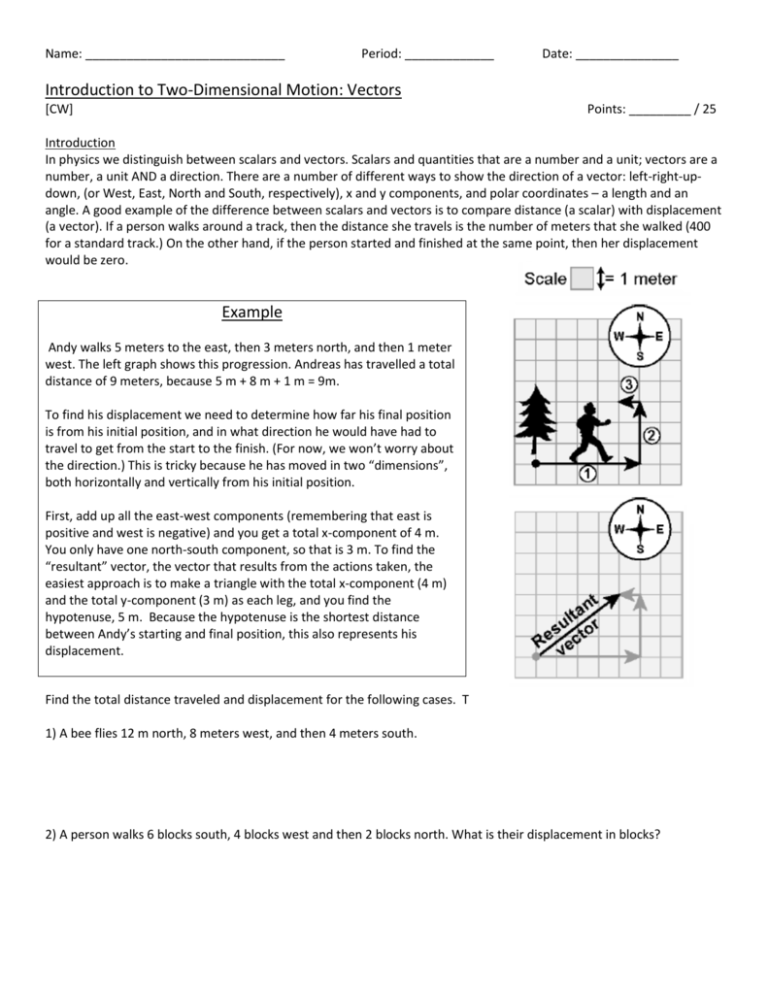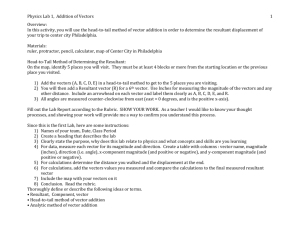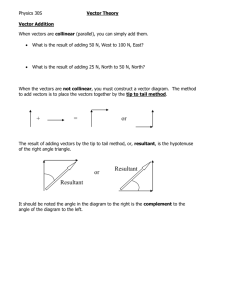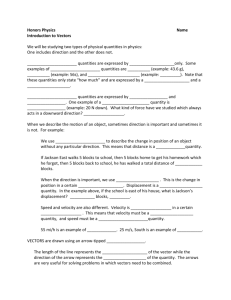Component Vectors
advertisement

Name: _____________________________ Period: _____________ Date: _______________ Introduction to Two-Dimensional Motion: Vectors [CW] Points: _________ / 25 Introduction In physics we distinguish between scalars and vectors. Scalars and quantities that are a number and a unit; vectors are a number, a unit AND a direction. There are a number of different ways to show the direction of a vector: left-right-updown, (or West, East, North and South, respectively), x and y components, and polar coordinates – a length and an angle. A good example of the difference between scalars and vectors is to compare distance (a scalar) with displacement (a vector). If a person walks around a track, then the distance she travels is the number of meters that she walked (400 for a standard track.) On the other hand, if the person started and finished at the same point, then her displacement would be zero. Example Andy walks 5 meters to the east, then 3 meters north, and then 1 meter west. The left graph shows this progression. Andreas has travelled a total distance of 9 meters, because 5 m + 8 m + 1 m = 9m. To find his displacement we need to determine how far his final position is from his initial position, and in what direction he would have had to travel to get from the start to the finish. (For now, we won’t worry about the direction.) This is tricky because he has moved in two “dimensions”, both horizontally and vertically from his initial position. First, add up all the east-west components (remembering that east is positive and west is negative) and you get a total x-component of 4 m. You only have one north-south component, so that is 3 m. To find the “resultant” vector, the vector that results from the actions taken, the easiest approach is to make a triangle with the total x-component (4 m) and the total y-component (3 m) as each leg, and you find the hypotenuse, 5 m. Because the hypotenuse is the shortest distance between Andy’s starting and final position, this also represents his displacement. Find the total distance traveled and displacement for the following cases. T 1) A bee flies 12 m north, 8 meters west, and then 4 meters south. 2) A person walks 6 blocks south, 4 blocks west and then 2 blocks north. What is their displacement in blocks? Solving Vectors Using x and y components Another way to write this type of problem is to use x and y component notation instead of using the compass directions. This is when you write things in the form (x,y). To solve this type of problem you need to add up all the x-components and, separately, add up all the y-components. Sometimes you will be asked to put the result on a graph, other times you can just write the result in x and y component notation. Example: Add the following three vectors (5 , 6) m, (-2, 0) m , (4 , -2) m Solution: The x-components are 5 + (-2) + 4 = 7m The y-components are 6 + 0 + (-2) = 4m Thus, the resultant vector is (7 , 4)m For 3 and 4 below add the vectors to determine the resultant vector: 3) (-5 , 4) m, (8 , -8) m, (3 , -2) 4) (0 , -12) m, (8 , 7) m , (-4 , 5) m 5) Three vectors are added and the resultant is (-8 , 6) m. If two of the vectors are (3 , 6) m and (-5, 4) m find the third vector. Describing Direction Using x and y components Vector quantities must include numerical value, units and direction. Direction can be generally described in cardinal directions such as north, east, or southwest. However, these do no aide in mathematical computations for vector quantities such as velocity or force. A more useful description of direction is given by the angle that the resultant vector makes with the horizontal axis. Consider that the resultant vector has x and y components that mimic bases of a right triangle. Applying basic trigonometric functions (think SOH-CAH-TOA) will allow us to derive general relationships between each vector component (x and y), the resultant vector, and the angle made between the resultant and the horizontal axis. As shown to the right (and in your textbook), each leg of the triangle is given by the x or y component of the vector. “R” represents the resultant vector. Basic trig relationships show us the connection between these values. Calculate the following unknowns using trigonometry as described above. Use a calculator, but show all of your work. Please include appropriate units with all answers. Component Vectors The most practical application of vectors deals with velocities and forces. When we speak of “speed” and “velocity”, we are usually describing the overall, or resultant, velocity. We rarely speak of velocity components. However, we must be able to resolve a vector into its components in order to properly apply kinematics equations (more on that later…). Any resultant vector can be described in terms of its x and y components, the legs of the hypothetical triangle that the vector makes. The x component starts at the beginning of the resultant vector and extends to the furthest horizontal position that the resultant vector reaches. The same concept applies vertically to the y-component. 𝑆𝑖𝑛 (𝜃) = 𝑉𝑦 𝑉 𝐶𝑜𝑠(𝜃) = 𝑉𝑥 𝑉 𝑇𝑎𝑛 (𝜃) = 𝑉𝑦 𝑉𝑥 Although the shape does not form a closed triangle, the lengths and direction of each component vector are the same as they would be for a right triangle. Thus, the same trigonometric functions apply as outlined above. 10. Using dotted lines, draw the horizontal and vertical components for each vector shown below. 20 m/s at -75o 9 m/s at 20o 40 m/s at 40o 15 m/s at - 40o 6 m/s at 90o 45 m/s at -70o 15 m/s at 80o 50 m/s at 0o 100 m/s at -30o 11. Using the angles given on the diagrams in problem #1 above, calculate the values of the horizontal (Vx) and vertical (Vy) components for each diagram you did above, showing your work in the box for each below. Note: Be sure your calculator is in “DEGREE” mode before doing your calculations. Vx = Vy = Vx = Vy = Vx = Vy = Vx = Vy = Vx = Vy = Vx = Vy = Vx = Vy = Vx = Vy = Vx = Vy =






